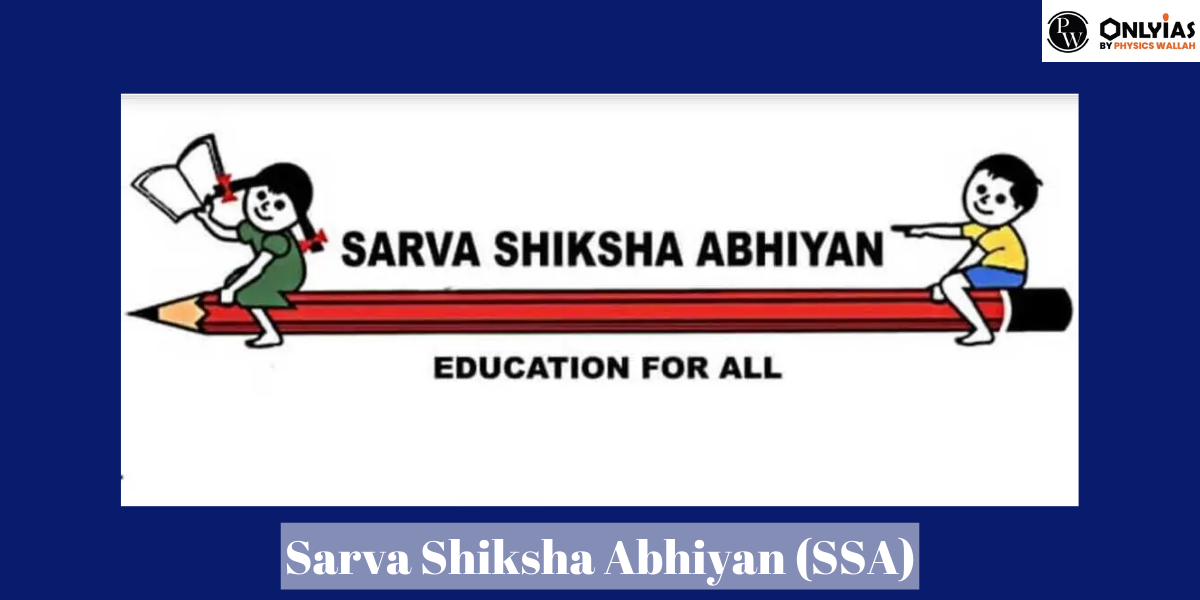![]() Madhavi Gaur
Madhavi Gaur
![]() September 30, 2023 08:22
September 30, 2023 08:22
![]() 7380
7380
![]() 0
0
Sarva Shiksha Abhiyan is a crucial government program that wants to make sure every child from 6 to 14 years old gets free and mandatory education. To learn more about SSA check out this article.

Sarva Shiksha Abhiyan is an important government program that wants all children from 6 to 14 years old to go to school. It provides free and mandatory education for them in a specific time.
For those preparing for the UPSC IAS exam, Sarva Shiksha Abhiyan is a crucial topic in the Social Justice part of General Studies Paper-2. This article looks closely at Sarva Shiksha Abhiyan, its main goals, how it works, special features, and why it matters for the UPSC exam.
Sarva Shiksha Abhiyan (SSA) stands as a cornerstone in the government’s efforts to achieve Universalisation of Elementary Education (UEE). Launched in 2001, this flagship program received constitutional support with the recognition of free and compulsory education for children aged 6-14 as a fundamental right under Article 21 A of the Indian Constitution. Administered by the Ministry of Human Resource Development (MHRD), Government of India, SSA has been in operation since 2000-2001.
This article serves as a valuable resource for IAS Exam GS-II aspirants, providing essential insights into Sarva Shiksha Abhiyan’s objectives and impact.
The Aim of SSA are:
1. To give free education to all children aged 6-14.
2. Remove differences between different areas and communities by involving the community in school management.
3. Teach children good values so they care about each other instead of only thinking about themselves.
4. Understand the importance of taking care of children from 0 to 14 years old.
5. Give children a chance to learn and grow in their surroundings, helping them develop spiritually and materially.
| Aspect | Details |
|---|---|
| Full Form | Sarva Shiksha Abhiyan |
| Year of Launch | 2001 |
| Government Ministry | Ministry of Human Resources and Development (MHRD) |
| Official Website | MHRD SSA |
SSA, often termed as an ‘Education for All’ movement, was spearheaded by former Prime Minister Atal Bihari Vajpayee. It operates through a partnership between the Central Government and State Governments. Initially aiming to achieve its objectives by 2010, SSA’s timeline was later extended.
Following the enactment of the Right To Education Act in 2010, SSA adopts a comprehensive strategy to achieve its objectives. The overarching goals of SSA are outlined as follows:
The primary areas of focus under the Universalization of Elementary Education (UEE) include universal access, universal enrollment, universal retention, and ensuring quality elementary education for all children.
The harmonization of initiatives and interventions from diverse Ministries/Departments is a fundamental principle in the implementation of Sarva Shiksha Abhiyan (SSA) to accomplish its objectives. The schemes/programs of other ministries/departments identified for convergence with SSA include:
SSA and District Primary Education Programme (DPEP) The District Primary Education Programme, initiated in 1994 as a centrally-sponsored scheme, aimed to rejuvenate the primary education system. It was the inaugural program with a specific focus on universalizing elementary education, adopting an area-specific approach with a district as the unit of planning.
| Constitutional Basis | Education Mandate |
|---|---|
| Constitutional Mandate of 1950 | The State is directed to provide free and compulsory education to all children until they reach 14 years of age. Note: The mandate encourages the State to achieve this within ten years of the commencement of the Indian Constitution. |
| National Education Policy, 1986 | The policy emphasizes the universal retention of children in schools until they reach 14 years of age. It also resolves to provide free and compulsory education of satisfactory quality to children up to the age of 14 before India reaches the 21st Century. |
SSA has undertaken various initiatives to fulfill its objectives, some of which include:
| Initiative | Aim |
|---|---|
| Padhe Bharat Badhe Bharat | To enhance the reading and writing skills of Class I and Class II children, along with improving their mathematics skills. It has a twin-track approach: Early Reading and Writing with Comprehension focuses on language development through reading and writing comprehensions, while Early Mathematics aims to generate interest in mathematics related to the physical and social world. |
| Shagun Portal | Launched in 2017 to monitor the progress of Sarva Shiksha Abhiyan. |
| Shaala – Siddhi | School Standard Evaluation Programme that aids in achieving the goals of SSA. |
| Swachh Vidyalaya | National Campaign – Clean India: Clean Schools. The aim is to ensure that every school in India has functioning and well-maintained water, sanitation, and hygiene facilities. |
Sarva Shiksha Abhiyan remains pivotal in India’s educational landscape, striving for universal elementary education and fostering a positive impact on various aspects of the schooling system. The convergence of ministries and schemes reflects a collaborative approach to achieve its overarching objectives.
<div class="new-fform">
</div>

Latest Comments